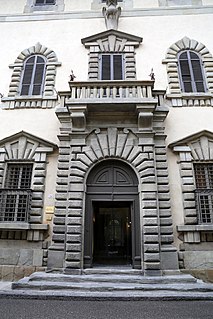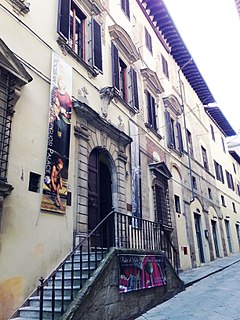
Pescia is an Italian city in the province of Pistoia, Tuscany, central Italy.

Giacinto Gimignani was an Italian painter, active mainly in Rome, during the Baroque period. He was also an engraver in aquaforte.
Banca Cassa di Risparmio di Firenze S.p.A. known as Banca CR Firenze, was an Italian savings bank. Once a listed company, the group now part of Intesa Sanpaolo since 2007.
Cassa di Risparmio is the Italian word for savings bank, and may refer to:

The Palazzo Nonfinito is a Mannerist-style palace located on Via del Proconsolo #12, in central Florence, region of Tuscany, Italy. Begun in 1593 using designs by the architect Bernardo Buontalenti, only the first floor was completed, and additional construction was added later by different architects. The Palace is presently the home of the Anthropology and Ethnology section of the Museum of Natural History of Florence.
Cassa di Risparmio di San Miniato S.p.A. (Carismi) was an Italian savings bank based in San Miniato, in the Province of Pisa, Tuscany. It was takeover by Crédit Agricole via its Crédit Agricole Italia division.
Cassa di Risparmio di Pisa is a former Italian saving bank and charity organization, based in Pisa, Tuscany. The bank was spin off into a banking foundation and a Società per Azioni in 1992.
Cassa di Risparmi di Livorno is a former Italian regional bank and charity organization, based in Livorno, Tuscany. In 1992 the organization was split into a limited company and a banking foundation Fondazione Cassa di Risparmi di Livorno.
Cassa di Risparmio di Pistoia e della Lucchesia is an Italian regional bank based in Pistoia, Tuscany. The bank was a subsidiary of Banca CR Firenze, with Intesa Sanpaolo as the ultimate holding company.

CDP Reti S.p.A. is an Italian holding company. It is a joint venture of Cassa Depositi e Prestiti, State Grid Corporation of China and other investors.
Associazione di Fondazioni e di Casse di Risparmio S.p.A. is an Italian banking association. The members were the savings banks of Italy, or the foundation that originate from the reform trigger by Legge Amato.

The Palazzo Marchetti is a Baroque-style palace located at Via Curtatone e Montanara in central Pistoia, Tuscany, Italy. The palace, which once served as a civic art gallery, is used in 2019 as a civic archive for various family collections of documents.

The Palazzo Ganucci Cancellieri is a late-Mannerist-style palace located at Via Curtatone e Montanara #51 in central Pistoia, Tuscany, Italy.

The Palazzo Rospigliosi a Ripa del Sale or Rospigliosi sulla Ripa is a former aristocratic palace located at Via Ripa del Sale number 3 in central Pistoia, Tuscany, Italy. The location is in a small alley adjacent to the Pistoia Cathedral, within the most ancient set of city walls. In the 19th century, the palace was donated to the diocese and now is used as both Diocesan museum and for the display of the collection donated by Clemente Rospigliosi.

The Palazzo Rospigliosi a Via del Duca is a former aristocratic palace located at Via Ripa del Sale number 3 in central Pistoia, Tuscany, Italy. The palace was the birthplace in 1600 of Giulio Rospiglio, later Pope Clement IX.

The Palazzo degli Anziani also known as the Palazzo del Comune, della Comunitá or del Giano is a Gothic-style stone palace located in the ancient historic center of Pistoia, Tuscany, Italy. The palace served as city hall for centuries; it still belongs to the comune and now mainly houses the Museo Civico d'Arte Antica.
The Palazzo Rossi is a former aristocratic palace located at Via Rossi in central Pistoia, Tuscany, Italy. The palace now serves in part to house collections and offices of the Fondazione Cassa di Risparmio di Pistoia e Pescia.
The Palazzo del Priorino is a Baroque-style palace on Via Pacini in central Pistoia, Tuscany, Italy.
Mario Nannini was an Italian painter, active in a Futurist style.

The Monument to Niccolò Fortiguerra is a marble statue of the Cardinal Fortiguerra, a prominent 15th-century benefactor of Pistoia, who endowed the city with a school for the indigent and a library. The latter still exists in the city. The statue stands atop a simple high marble pedestal in the piazza of Santo Spirito, in Pistoia, region of Tuscany, Italy.










